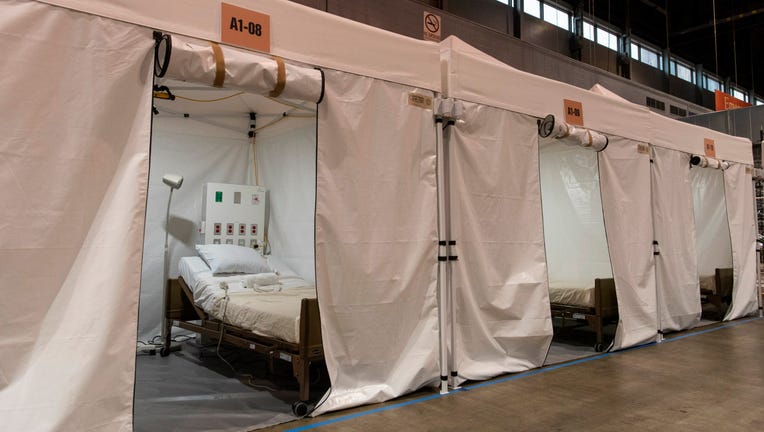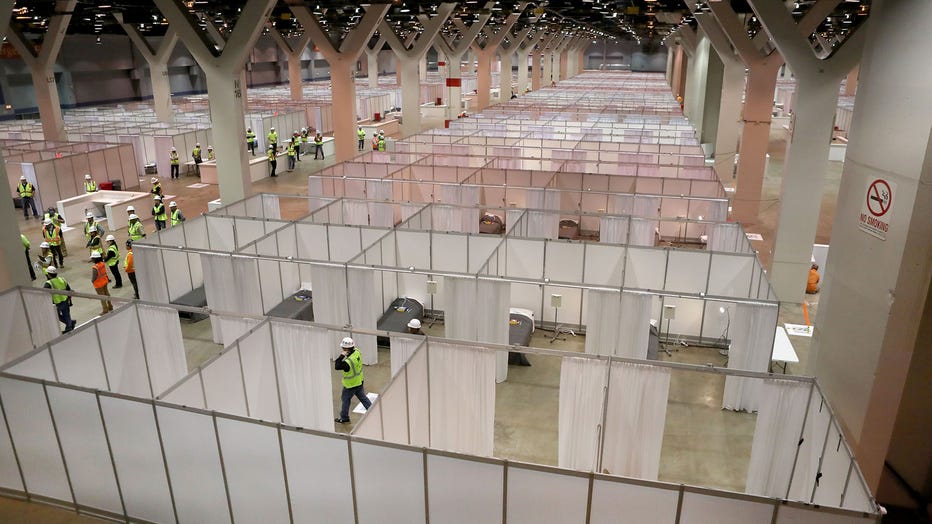Slowed COVID-19 spread leaves thousands of makeshift beds empty

Tents serve as patient care rooms at the COVID-19 alternate care facility constructed inside of the McCormick Place convention center in Chicago, Illinois on April 17, 2020 in Chicago, Illinois. The facility, which began seeing patients Thursday, wil (Tyler LaRiviere - Pool/Getty Images / Getty Images)
SPRINGFIELD, Ill. - Illinois has spent tens of millions of dollars building makeshift field hospitals to prepare for an anticipated flood of coronavirus cases, but so far has not had to use the thousands of extra beds. That was exactly the plan.
The state government says prevention strategies such as social distancing and a statewide stay-at-home order have worked so well that a small city of beds proposed for McCormick Place in Chicago — the nation’s largest convention center — has been dramatically reduced. Beds hastily installed at three closed hospitals in suburban Chicago remain on standby, while renovation of a former hospital in Springfield has yet to begin.
“We’ve talked a lot about standing down,” Gov. J.B. Pritzker said this week. “I don’t want to speak too soon because all of these identified alternate care facilities need to be in a state of some kind of readiness in the event that there’s a surge, either because, God forbid, we reopen too fast or because there’s a surge that people expect in the fall.”
It’s a bright spot in the monthslong pandemic.

Construction workers put the finishing touches on Hall C Unit 1 of the COVID-19 alternate site at McCormick Place in Chicago on Friday, April 3, 2020. Hall C will house 500 beds. (Chris Sweda/Chicago Tribune/Tribune News Service via Getty Images)
The virus has devastated Illinois, where 50,355 people have tested positive and 2,215 have died. The actual number of infections is thought to be far higher because many people have not been tested and studies suggest that people can be infected without feeling sick.
Five weeks ago, Pritzker laid out a grim worst-case scenario: If virus-containment failed, the state would need 38,000 more hospital beds, including 9,000 equipped for intensive care.
That prompted a scramble for space. On April 3, Pritzker and Chicago Mayor Lori Lightfoot rechristened McCormick Place as a field hospital for COVID-19 patients, praising the U.S. Army Corps of Engineers for around-the-clock work to ready the first 500 beds.
But the goal was always to keep it empty. If the beds are never used, “then we will have done our job,” the governor said.
COMPLETE CORONAVIRUS COVERAGE HERE
So far, existing hospital bed space has largely sufficed. As of last week, just 12 patients had been treated at McCormick Place, and six of those were released.
For most people, the new coronavirus causes mild or moderate symptoms, such as fever and cough that clear up in two to three weeks. For some, especially older adults and people with existing health problems, it can cause more severe illness, including pneumonia.
The state also secured four closed hospitals to serve as care facilities in case extra bed space was needed, and the first three of those are ready to accept patients. The former Advocate Sherman Hospital in the southwestern Chicago suburb of Elgin has 283 beds; the former MetroSouth Medical Center in the south Cook County city of Blue Island has 585 beds; and the shuttered Westlake Hospital in Melrose Park, just northwest of Chicago, has 435 beds.
No work has yet been done on a much smaller ex-hospital, Vibra in Springfield, where there are far fewer cases of COVID-19.
GET FOX 32 NEWS ON THE GO BY CLICKING HERE
Pritzker, a Democrat, has said he doesn’t yet know how much it cost to transform McCormick Place or the four shuttered hospitals. Crain’s Chicago Business, citing a Chicago budget document, reported that the city would spend $64 million on the McCormick Place build-out. It said city officials hope for federal reimbursement.
The costs include $8 million for 254 health care workers recruited to staff the first 500 beds. The eight-week contract with Favorite Healthcare Staffing provides everything the nurses and other staffers need, including insurance, lodging, meals and travel. Officials noted that the state has the right to use the health care workers at other sites if necessary.

